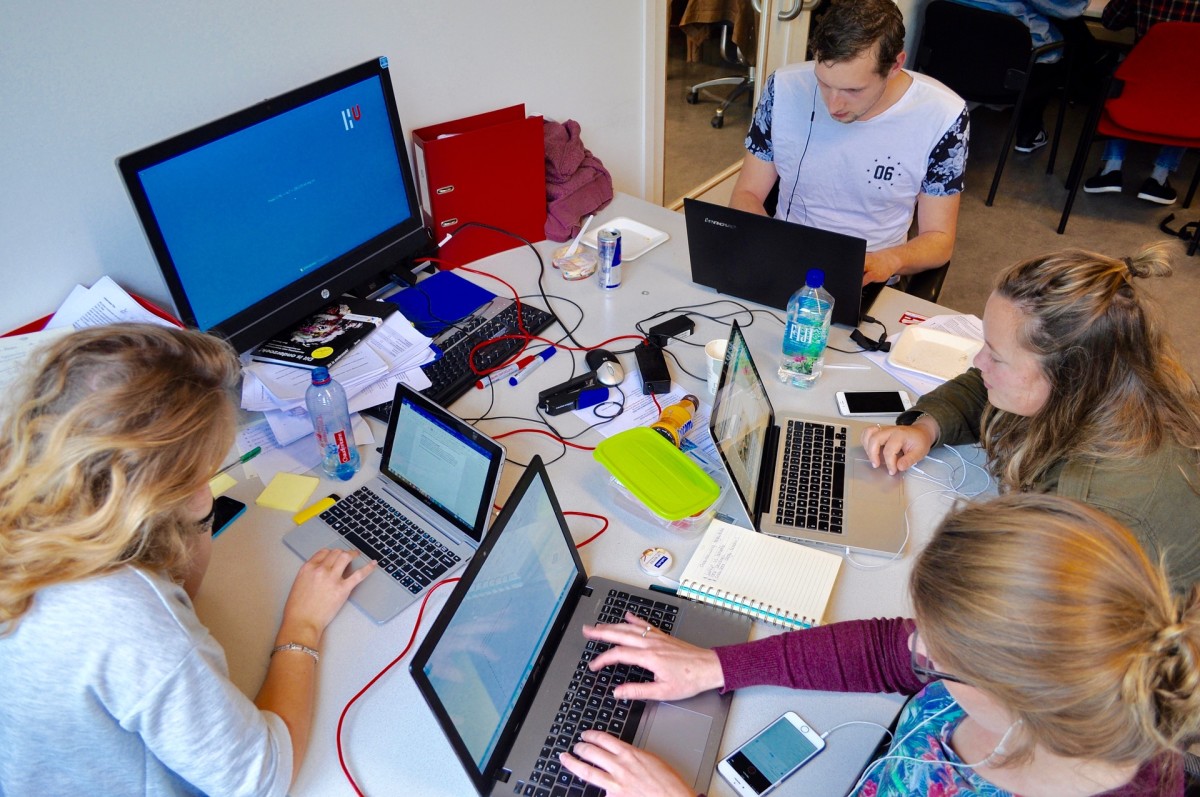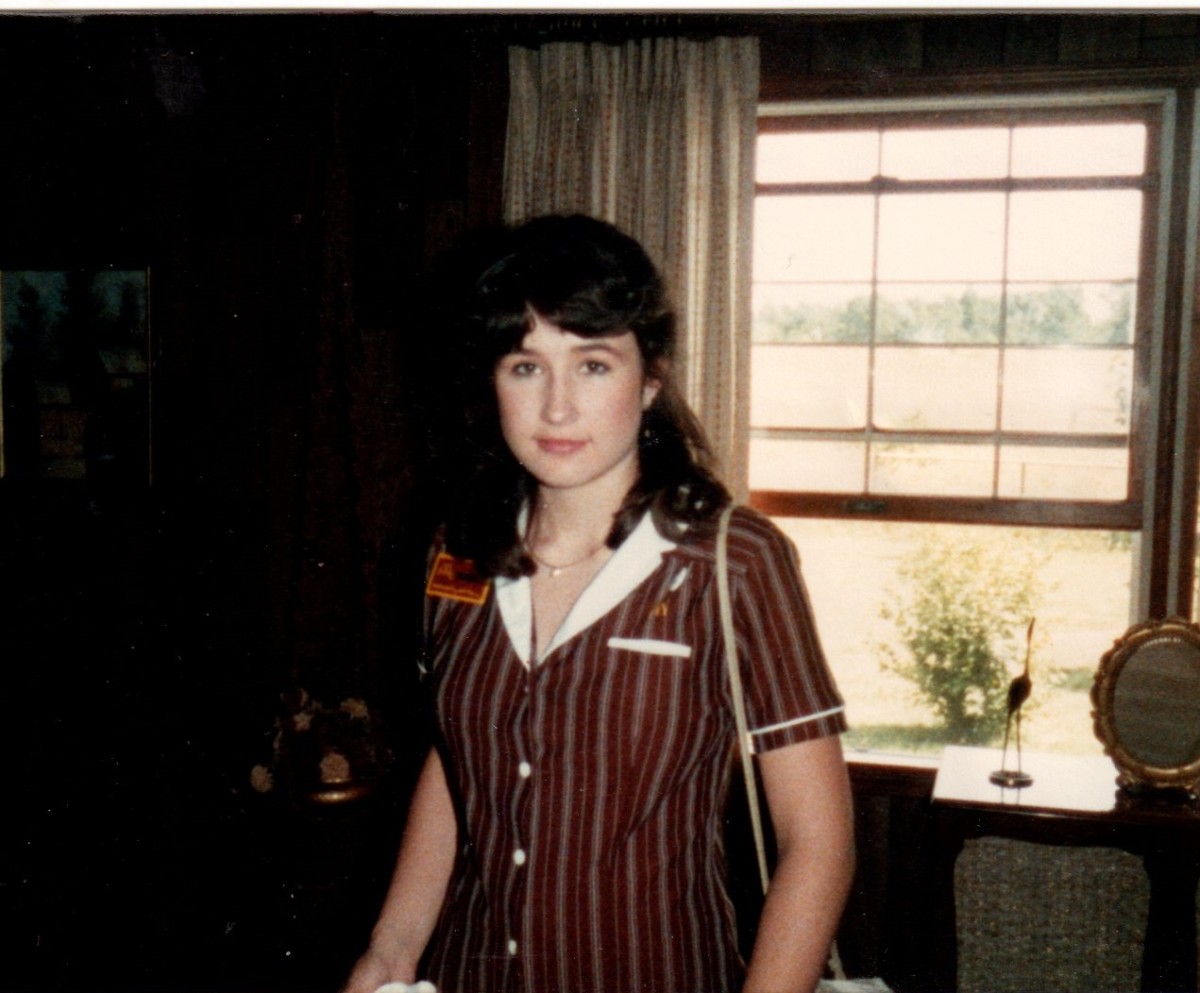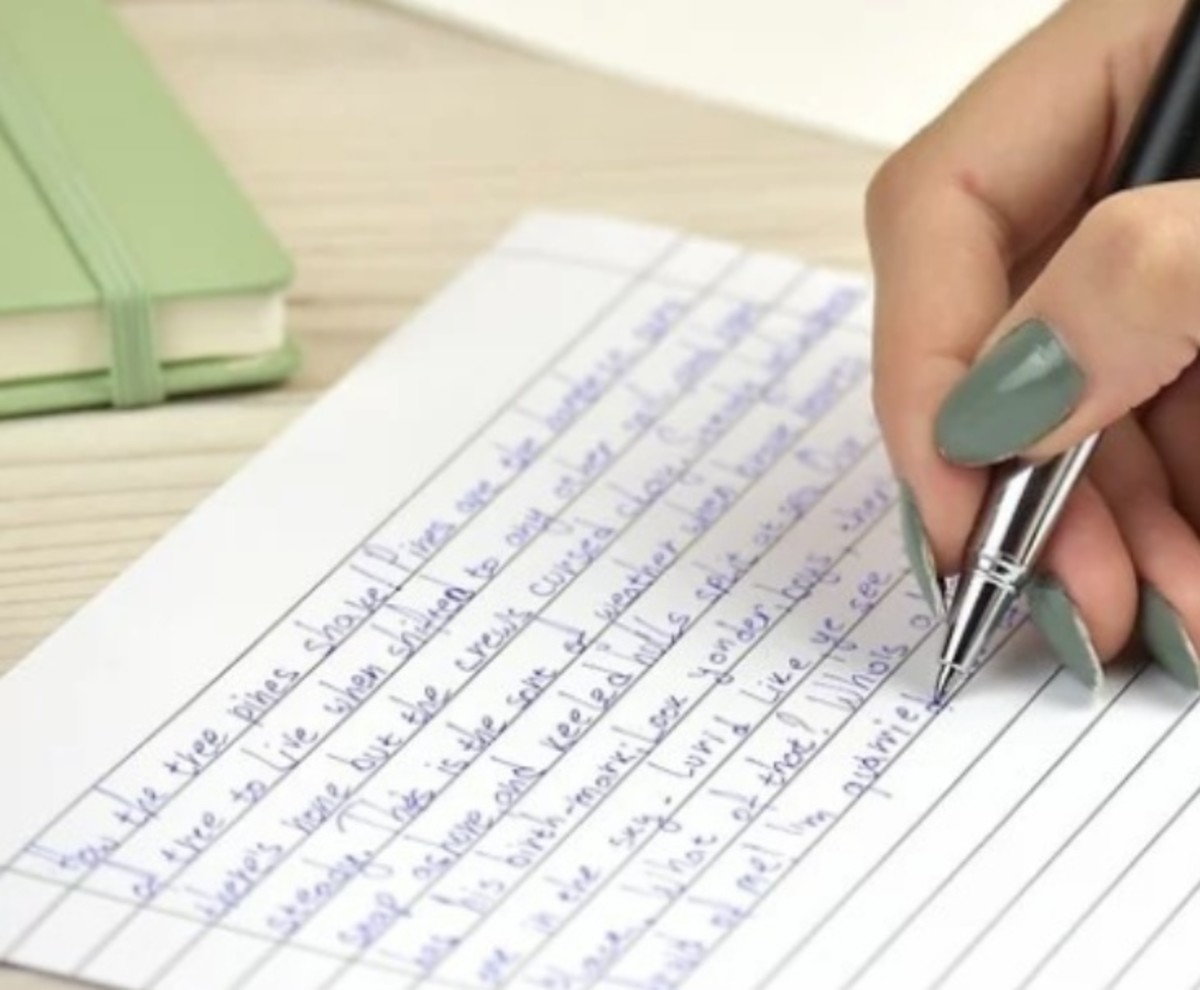How to Write a Research Essay
Term paper writing process
The research essay process really only has three basic steps.
- Prewriting
- Writing
- Editing.
Within these steps are many substeps, but if you remember these basic ones, you are off to a good start. Many students are under the illusion that the essay has to come out fully formed, and that most people just know what to do. Would you be surprised to know that most of writing is actually "not-writing"? Read on.
Easy essay writing tips for students
If you are student reading this, you can take comfort in the fact that your fellow students also struggle with how to write a research essay. I know. I have seen it thousands of times. Mostly, this is because these student haven’t broken up the process into bite-sized steps.
Of course, many leave the work to the last minute, get into an emotional funk, freeze their creativity, and then hope that by quickly getting something down, they will quickly produce something intelligent. Stop. Backtrack. Follow these easy steps and you will save yourself some grief.
Prewriting
As I said, most of the writing process involves not writing. Prewriting, the first step is one of them. This involves reading the instructions carefully, brainstorming (in different ways), outlining and researching.
Step 1: Read the instructions carefully
The most important step in writing a research essay is to read your instructor’s assignment details carefully. You’ see, your teacher has actually taken the time to tell you what he/she wants.
Also remember while you are reading that there’s a reason he/she has given you the assignment: to help you think critically, synthesize information, think clearly about it and then discuss it in writing. Doing this assignment means you will actually learn something.
The biggest single reason that students lose marks on research papers is the failure to read the instructions, understand them and to do what is asked. Let me say that again. The biggest single reason for students losing marks on assignments is the failure to read, understand and follow the instructions.
I have my theories. I have written elsewhere about this. So take some time, fix yourself your favourite non-alcoholic beverage and read the instructions line by line. Be sure you understand what is being asked of you. And ask someone (your teacher/TA/professor/fellow classmate) if you do not understand.
Brainstorming

Mind Map
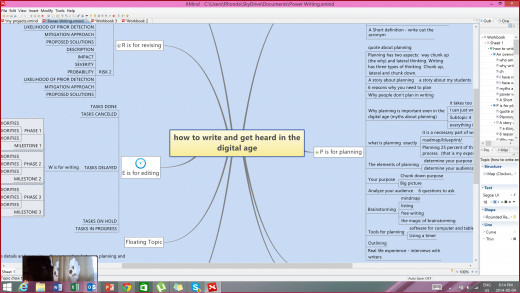
Step 2: Brainstorming
This is the fun part of writing an essay. If the prof or teacher hasn’t assigned a topic and told you to pick one yourself, then take a piece of paper and doodle or draw a mind map. Make a list. Browse the internet. Let the ideas flow in, then narrow it down.
If you have been assigned a topic, or if you have to pick from a finite list, then pick one that you want to write about. It’s much easier to write about something you care about than to not write about something you don’t care about.
Brainstorming for me is the best part of writing. This is the time that you can put down anything –to do it well, just put down anything you like and don’t censor yourself. Anything goes.
Once you brainstorm and have drawn a mind map, doodled or whatever works, the next step in how to write a term paper is to prewrite some more.
One way to do this is by “freewriting”. Take your brainstorm, write some more. Do some internet browsing so what you come up with.some basic information on your topic. Just write. One prompt I like to give students is to see if they can answer the question why do they want to write about this topic?
After you brainstorm and freewrite, create a working thesis – Sometimes your professor or teacher will give the thesis straight out. Sometimes he/she won’t. The thesis is usually the answer to a big question that your topic poses. It is a statement or conclusion you can make about the information that you will then back up with support points.
Essay Map
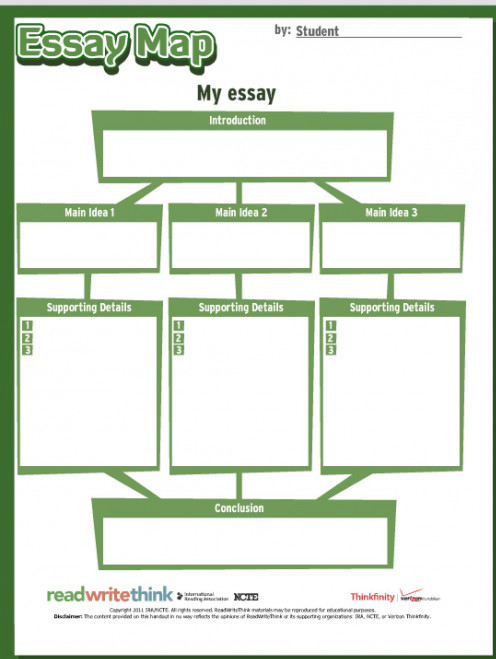
Step 3: Researching and Outlining
These steps go together. We're still into prewriting here. Especially focus on your arguments that support your thesis. Try not to be perfect. Perfectionism is your enemy. Get it down and then get it right. Yes, of course you may not know everything you are going to say, but you know enough. You can always add to the paper later. Use a timer to work in bursts for each paragraph outline. Answer at least three questions (usually what the point is, why it is important, how supports your argument). As you add more information, start to organize it. The organizer diagram on your right can give you some ideas and you can download this form at the link under the picture.
Getting back to resesarching, you'll need to find information. Start with your course materials. The texts, notes and articles all have good information. In fact, your teacher or professor wants you to use these. The purpose of your assignment, in many cases, will to ensure you synthesize your course materials.
Nex,t start searching. The best place will be your school library. You can find relevant ebooks and articles through online databases. Or, the old fashioned way of asking the librarian to help is also effective.
If you venture onto the internet, apply some discernment. Check each webiste carefully to determine who has put it out (an organization or a business), who has authored the material (Joe Schmo, or Dr. X, Phd.), and when the material was written. This will help you assess how credible the information is. Credibility counts on a school essay. Speaking of credible sources, try to stay away from Wikipedia.
When you are doing a Google search Wikipedia will certainly appear at the top of the list. This doesn't mean it is credible. Some of its contents are OK, and some of it isn't. At the very least, Wikipedia can provide a starting spot and links and surface inforamtion for you to follow up on.
Writing
Step 4: Drafting
We're into the second major phase here. (Recall, that the first one was pre writing). Pre writing for me often takes about 25 to 30 percent of my time. I call it the thinking and exploring phase. The actual writing of the draft, takes maybe another 25 per cent of my time (of course, it varies from person to person). Writing your first draft is the hardest part. Once you have written it, all you need to do is fix it. Many students struggle with the drafting part because they think it needs to be perfect; it doesn't.
Write your first draft from your outline. This is your roadmap and will eliminate a lot of the stress of writing. Don't worry if it is not perfect or fully researched. Remember, most of writing is fixing. So get it down, and get it right later.
Use a timer. Challenge yourself. Write and keep writing. Try to avoid getting distracted by the internet. Write it by hand if that works better (it will take more time). Then input it. For and my students, though, there is nothing that works better than timed writing when creating a first draft.
Editing
We're into the last phase of the writing process - editing. Editing has two parts: revising and proofreading. Revising is where you do some heavy lifting on the writing. You change it, rewrite it and reorder it. Proofing is more picky. Here, you look for small grammar, spelling, typose and punctuation errors.
Step 5: Revising
Revision is a crucial part of writing. When you revise you are making major changes and fixes. These could involve adding more research or even cutting points that don't support the argument or the thesis or changing the logic in the arguments, and the sequencing of the paragraphs or sentences.
When I revise, I usually print out a hard copy draft and make notes in the margins, and cross out words. The best thing is to take a break between the time you draft and revise. That way, you can become more detached from your work.
Also, during this phase, it is a good idea to review the professor or teacher's assigment write up just to make sure you have covered all the bases.
Step 6: proofread you work
Ok. You've done all the revisions, tweaking, reording and fixing on the text that you can. You've done more research, added and subtracted information and polished the writing. Now it's time for the finishing touches: proofreading.
Proofreading is picky but necessary. If you fail to proofread, you could lose about 10% of your grade. Some instructors are quite fussy. Build proofreading time into your essay project. You won't regret it. I have seen many a student rush into class, out of breath, fresh from the computer, essay in hand (relieved to have gotten it done) only to have neglected to do the proofreading. .
My first suggestion is to start with the spell-check and grammar check functions of your particular wordprocessor.This will identify the obvious errors I'm assuming here that most of you have MS Word. Right click every squiggle and double check it. (Occasionally, MS Word does misidentify the error).
Another technique I like is to print out the draft, and read it outloud, pencil in hand. There is a certain magic that happens when I am doing this. I am able to better focus in on errors, and identify them. After a hard-copy mark-up I then input the changes.
As I mentioned before, take a short break before any writing, fixing and proofreading. Why? When we write, we are using the right side of the brain. This side of the brain is better for flow and style, but doesn't do well for details. That is the job of the left side of the brain. So taking a short break helps us switch. Also, we are attached to our own words, and miss things. You will not find all of your errors after you write. For me, I need two hard copy passes--minimum.
Essay checklist
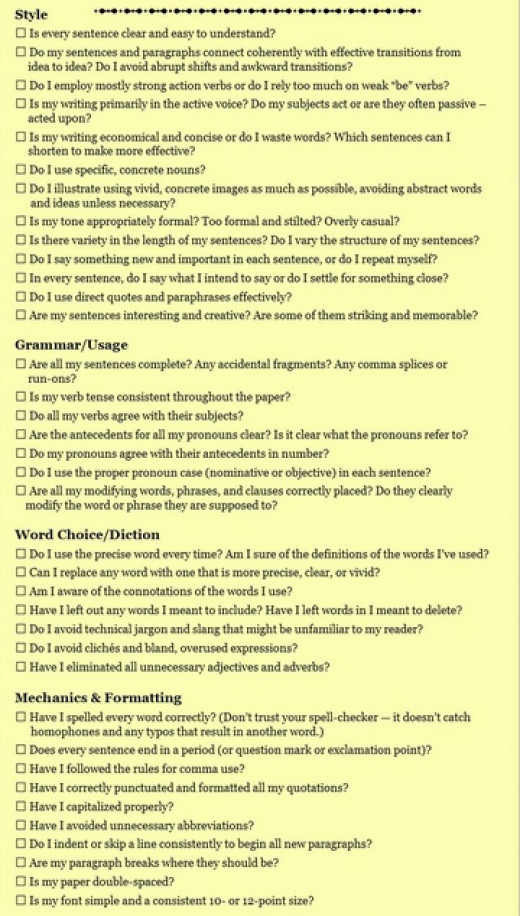
To Summarize
Here is the three-step process for writing research essays:
1. Prewrite
- read the instructions carefully
- brainstorm
- preewrite
- outline
- research
2. Draft
- write your rough draft
3. Edit
- Revise
- Proofread
Don't forget to check your documentation !
Bonus tip- Check your documentation
This is not exactly prewriting, writing, and editing, but it is crucial. You need to check your documentation. Hopefully, you have been keeping track of your sources. Often, I see students throw this in right at the end in a sloppy fashion. Again, you can lose marks here. Good documentation is academically responsible, of course. Chances are your instructor has told you to use APA, MLA or Chicago styles.
So, first, ensure that you have documented accurately. Next, ensure that you have documented according to the style provided. You an do this using MS Word to format the paper. Just... Or you can use a tool such as Bibme ( available online for free at www.bibme.com) and it will help you put the references list in the right format.
Essay writing links
- Essay Help: Ten ways to avoid losing marks
For today's bit of essay help, I will offer you 10 suggestions to prevent you from losing marks on your essay assignment
- Buy your college essay online: Four good reasons not...
Buy your college essay online? Really? I'll give you some reasons why you should never do this. With the Internet, the world has become one big global market place where essays are for sale, - How to write a research essay
When it comes to how to write a research essay, most students can always improve. Here are some steps. - Essay introduction in 3 parts
The essay introduction is one of the most important parts of the paper, yet one of the most difficult to write. Here are some strategies - how to write a conclusion for an essay
Here's how to write a conclusion for an essay - Six reasons why students fail in first term college
For many students, first term college heralds a new chapter, a new adventure in learning and in life. Yet a midst the excitement are adjustments as students transition to more responsibility. Some students have a rough ride navigating the changes and - How to write essay exams and succeed
Many students don't know how to write essay exams and do well. Here are some pointers - How to write college application essays: 10 tips
Admission essays not straightforward documents to write. There's a lot riding on them, and yours will be one of the most important documents you write. in your life. Here, are some more specific tips - How to Ace a take home exam-Nine tips for success
f you've just been assigned a take home exam and think that doing well on it will be a piece of cake, think again. Take home exams can be tricky. The advantage is that you are free of the stress of the exam room and all the issues around timed writin

